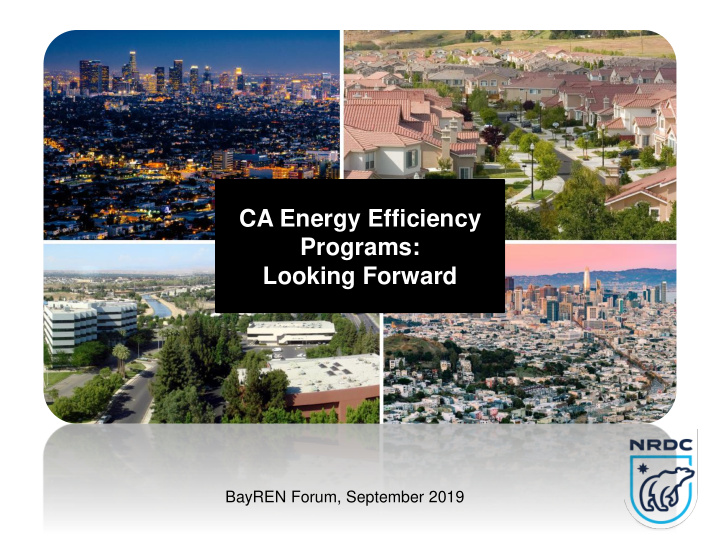



CA Energy Efficiency Programs: Looking Forward BayREN Forum, September 2019
What does this mean for buildings? Building Decarbonization Energy Efficiency Electrification Load Flexibility Use least energy From cleanest fuel At the right time 3
Gas use in buildings > GHG than all in-state power plants • Gas combustion in 10% buildings (12%) > all in-state power plants (10%) 12% • Not including building emissions from electricity and fugitive methane Source: www.arb.ca.gov/cc/inventory/data/data.htm, 2016 (1) For a 2.3% leakage rate and 20-year GWP 4
High-efficiency electric alternatives to gas use in residential buildings Heat-pump clothes dryer Electric fireplaces CA Gas Use in Homes - 2010 Dryer, 3% Misc, 4% Cooking, 7% Induction Water cooktop heating, 49% Space Heat-pump heating, water heater 37% Heat pump space heating 6
With load management, water heating can be electrified using clean renewable energy without adding to peak load Shed on peak Charge off peak NRDC and Ecotope study, ACEEE Aug. 2018 7
Policy Opportunities in California • Existing examples (LIWP, Advanced Energy Rebuild) • State building code and local govt reach codes • CPUC-funded energy efficiency programs • New building decarbonization programs (SB 1477) • Self Generation Incentive program (SGIP) funds?
CPUC-funded energy efficiency programs • 3-Prong Test **HUGE WIN** – The new “Fuel Substitution Test” will allow efficiency fuel substitution (gas<->electricity) – Opportunity for Action: 1) Work together now to identify and request approval for a set of high-opportunity electrification measures; 2) Work with EE program administrators to shape and launch new EE programs • New Market Transformation Framework – Decision pending in the EE proceeding
SB 1477 provides $200 million over 4 years This is a huge opportunity, but not a lot of money given the challenge… We must use these funds wisely to set us on the path to 2045 = under $20 per CA household In comparison: ~$1 billion / year for Energy Efficiency $100 million / year Solar on Multifamily Affordable Housing (MF only) ~$2 billion California Solar Initiative $1.2 billion Self-Generation Incentive Program $400 million New Solar Homes Partnership (new homes only)
BUILD + TECH Programs BUILD (Building Initiative for Low-Emissions Development) BUILD provides incentives that tap into the ingenuity of California’s builders to find innovative and low- cost ways to “build clean from the start” and gain market experience to make clean heating technologies common practice in new construction. SB 1477 is patterned on the successful New Solar Homes Partnership, which helped kickstart the market for rooftop solar in new buildings. TECH (Technology and Equipment for Clean Heating) TECH spurs market development for low-emissions space and water heating technologies by incentivizing distributors and retailers to make equipment available, and providing customer education and contractor training. This program will focus on technologies that have the greatest potential to reduce climate pollution, and that improve the health and safety of, and energy affordability for, low-income households.
CPUC Staff Proposal (not final)
SB 1477 Opportunities for Local Govt o Track the 1477 proceeding and make your voice heard where possible (e.g. BayREN has submitted comments) o Partner with the TECH and BUILD implementers to ensure the new programs meet the needs of your constituents o Look for ways to layer incentives and coordinate 1477 activities with local govt action and programs o Grant opportunities may be one opportunity through TECH – stay tuned! (decision expected by December 2019)
Thank you! Contact info: Merrian Borgeson Mborgeson@nrdc.org
Cut energy use, clean up the grid, electrify
How to reduce heating emissions? Natural gas Electricity & propane Fossil fuel extraction, Renewable Supply electricity distribution, storage Gas furnaces and Electric heat pumps water heating Demand Building energy efficiency 16
Heat pumps 101 300% to Cooling Heating 400% efficient! Extracts, concentrates, and moves heat from surrounding air into tank or building Like a fridge or A/C in reverse 17
Heat pumps 101 Collects, concentrates, and moves heat from surrounding air into tank or building Like a fridge or A/C in reverse 200% to 400% efficient! 18
Air source / ground source (“geothermal”) Air-source • Collects heat from ambient air • Less efficient in cold weather (but cold climate models operate down to -20 F) • Most common in CA Ground- source (“geothermal”) • Collects heat from the ground • Higher efficiency at cold temperatures • Much more expensive. • Best for very cold climates 19
Heat pump water heating Heat pump water heaters are a mature technology with a wide range of affordable models in the market Popular models: AO Smith Bradford Rheem Stiebel Sanden White Eltron 100+ ENERGY STAR models 20
Hybrid heat pumps Many heat pumps are “hybrids”, they have both a heat pump, and a backup resistive element for: ➢ high demand periods ➢ very cold periods Like plug-in hybrid cars (e.g. Chevy Volt) But new technologies can work down to -20F in heat pump only mode 21
Heat pump space heating Heat pumps provide both heating and cooling (replace A/C) Three main types of heat pumps for residential space heating and cooling: Central heat pump Ductless heat pump Packaged terminal (“Mini - split”) heat pump (PTHP) 22
Multi-family and commercial too! Multi-family Commercial buildings ❑ Dedicated (same as ❑ Same as residential single family) ❑ Larger units: ❑ Shared (central heat RTUs, VRFs… and hot water systems) 23
Recommend
More recommend